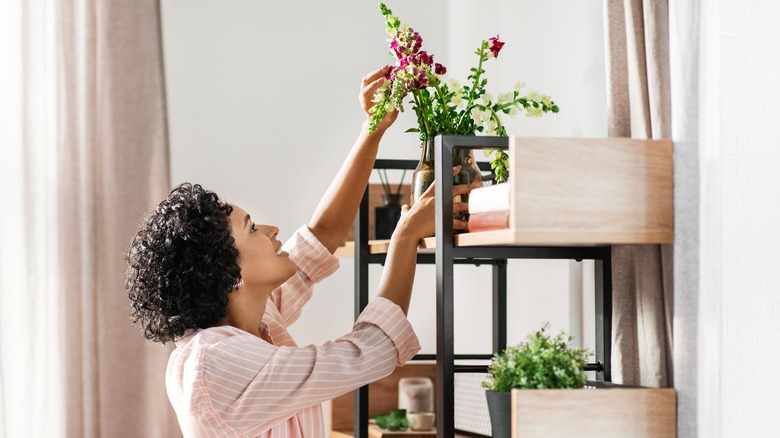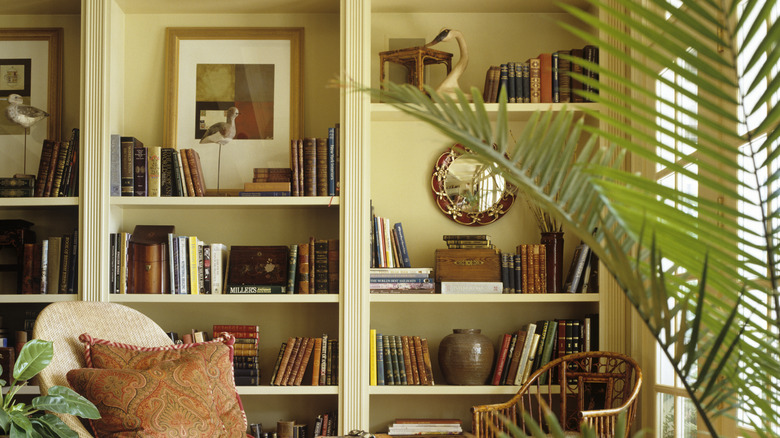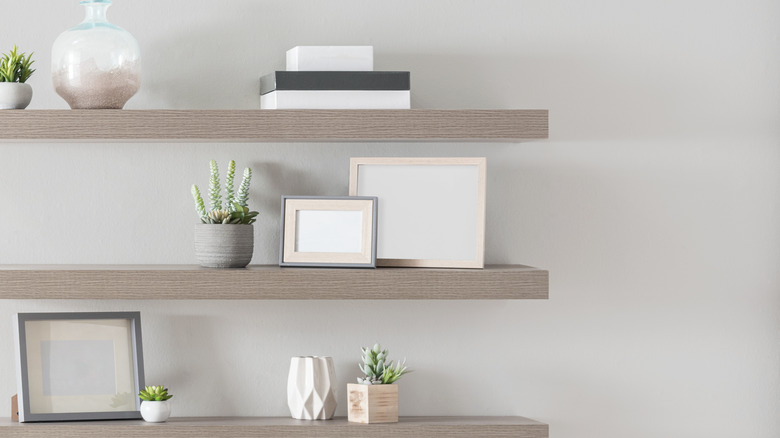Common Shelf Styling Mistakes You'll Want To Avoid For A More Polished Look
Styling a shelf might seem easy — just grab some books, a plant, and a cute vase, right? Not so fast! A well-designed shelf takes thought and a little know-how. Many unknowingly make a few common mistakes that leave their shelves looking cluttered, dull, or just "off." The top styling mistakes include ignoring the rule of three, using objects of the same shape, color, or height, and centering all your items without considering leaving some empty space.
The rule of three is a decorator's best friend, and for a good reason. This rule, favored by designers everywhere, involves grouping items in odd numbers — three being the magic number for creating balance and interest. This works because odd groupings are asymmetrical, and the eye finds asymmetry more engaging than symmetry. Executing this rule doesn't require fancy or expensive décor; just start with what you have at home. Look for items of varying sizes and shapes that can complement each other. For example, a small framed photo, a mid-sized ceramic bowl, and a tall candle holder can work wonders when grouped together. You could also group three of the same item but different heights together, such as three candlesticks. This three-item tip could be the perfect way to keep your shelves clutter-free for good, as it can also keep you from making another common design mistake: using too many tiny items. Larger pieces that are limited to odd numbers will create the most aesthetically-pleasing look.
The problem with being too matchy-matchy
Another common mistake people make when decorating shelves is using items that all have the same shape, height, or color. While it might seem safe and coordinated to stick with matching items, this approach leaves your shelves looking flat, almost like a robot designed them. This mistake is common when people buy pre-packaged décor sets or stick too closely to one style. It might be convenient, but it sacrifices creativity and uniqueness. When everything blends, nothing stands out. Your eye doesn't know where to focus, so the whole thing feels lifeless. Imagine a shelf full of only red books lined up in the same size. Sure, it's neat, but is it exciting? Not really.
Breaking up this uniformity requires embracing variety. Use items of different heights, shapes, and colors. Think about mixing a chunky white vase, a slim gold candlestick, and a stack of colorful books. The different textures and sizes will add depth and make your shelf feel dynamic. Leaning books or placing some horizontally instead of all standing vertically can also add interest.
Contrast is your best friend when styling shelves. Pair smooth objects with rough ones, dark colors with light, and round shapes with angular ones. This makes your shelves visually interesting and keeps them from falling into the "flat" trap. The goal is to create layers and movement so your shelf looks intentional and alive.
Don't make the mistake of suffocating your shelf
The last mistake is styling everything smack-dab in the center with no room to breathe. When you cram everything in the middle, it can feel cluttered, chaotic, and just plain overwhelming. A packed shelf doesn't just lack elegance; it also prevents each item from being appreciated fully. Think about it: Where does your eye go first if your shelf is crammed with decorations? Likely, nowhere. Everything blends, and nothing stands out.
The diamond rule is a simple trick to fix this. Style items in a triangular or diamond-shaped pattern. On a bookshelf with three shelves, this might look like placing one item in the center of the top and bottom shelves and two items on either side of the middle shelf. Also zig-zag similar items instead of placing them vertically above and below one another. Another example of this on a single shelf is to style tall-sized objects in the middle and smaller pieces at the sides. This keeps the eye moving naturally and leaves negative space for everything to breathe.
Negative space, aka empty areas, isn't wasted space — it's where the magic happens. This is one designer tip that will make your favorite décor pop in your home. It gives the eye a break and allows each item to shine. It's similar to pauses in a conversation; everything feels rushed and jumbled without them. When in doubt, remove an item or two. Over-styling is a common trap, but the best designs come from restraint.


